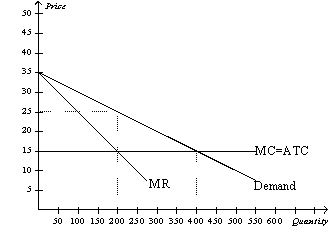A) P4 x Q3.
B) (P4-P2) x Q3.
C) (P4-P1) x Q3.
D) (P5-P0) x Q1.
F) C) and D)
Correct Answer

verified
Correct Answer
verified
Multiple Choice
Which of the following can defeat the profit-maximizing strategy of price discrimination?
A) consumer surplus
B) deadweight loss
C) market power
D) arbitrage
F) A) and D)
Correct Answer

verified
Correct Answer
verified
Multiple Choice
When a monopolist increases the amount of output that it produces and sells,average revenue
A) increases, and marginal revenue increases.
B) increases, and marginal revenue decreases.
C) decreases, and marginal revenue increases.
D) decreases, and marginal revenue decreases.
F) B) and D)
Correct Answer

verified
Correct Answer
verified
Multiple Choice
When a natural monopoly exists,it is
A) always cost effective for government-owned firms to produce the product.
B) never cost effective for one firm to produce the product.
C) always cost effective for two or more private firms to produce the product.
D) never cost effective for two or more private firms to produce the product.
F) A) and D)
Correct Answer

verified
Correct Answer
verified
Multiple Choice
A profit-maximizing monopolist charges a price of $14.The intersection of the marginal revenue curve and the marginal cost curve occurs where output is 15 units and marginal cost is $7.What is the monopolist's profit?
A) $90
B) $105
C) $180
D) Not enough information is given to determine the answer.
F) B) and D)
Correct Answer

verified
Correct Answer
verified
True/False
The socially efficient quantity is found where the demand curve intersects the marginal cost curve.
B) False
Correct Answer

verified
Correct Answer
verified
Multiple Choice
Table 15-9
Consider the following demand and cost information for a monopoly.
 -Refer to Table 15-9.What is the marginal cost of the 4th unit?
-Refer to Table 15-9.What is the marginal cost of the 4th unit?
A) $4
B) $14
C) $31
D) $62
F) A) and B)
Correct Answer

verified
Correct Answer
verified
Multiple Choice
Monopolies are socially inefficient because the price they charge is
A) equal to marginal revenue.
B) above marginal cost.
C) equal to demand.
D) above demand.
F) B) and D)
Correct Answer

verified
Correct Answer
verified
Multiple Choice
Suppose a firm has a monopoly on the sale of widgets and faces a downward-sloping demand curve.When selling the 100ᵗʰ widget,the firm will always receive
A) less marginal revenue on the 100th widget than it received on the 99th widget.
B) more average revenue on the 100th widget than it received on the 99th widget.
C) more total revenue on the 100 widgets than it received on the first 99 widgets.
D) a lower average cost per unit at 100 units output than at 99 units of output.
F) A) and B)
Correct Answer

verified
Correct Answer
verified
Multiple Choice
Table 15-6
A monopolist faces the following demand curve:
 -Refer to Table 15-6.What is the marginal revenue from the sale of the 4th unit?
-Refer to Table 15-6.What is the marginal revenue from the sale of the 4th unit?
A) $-3
B) $3
C) $9
D) $24
F) A) and B)
Correct Answer

verified
Correct Answer
verified
True/False
If a product can be produced by a natural monopoly,society will benefit in the form of lower prices if the monopolist is broken up into several smaller firms.
B) False
Correct Answer

verified
Correct Answer
verified
Multiple Choice
Figure 15-15
 -Refer to Figure 15-15.If there are no fixed costs of production,monopoly profit without price discrimination equals
-Refer to Figure 15-15.If there are no fixed costs of production,monopoly profit without price discrimination equals
A) $500.
B) $1,000.
C) $2,000.
D) $4,000.
F) None of the above
Correct Answer

verified
Correct Answer
verified
Multiple Choice
When a firm experiences continually declining average total costs,
A) the firm is a price taker.
B) society is better served by having one firm supply the product.
C) the firm will earn higher profits than if average total costs are increasing.
D) All of the above are correct.
F) A) and C)
Correct Answer

verified
Correct Answer
verified
Multiple Choice
Which of the following is the preferred strategy for the government to follow to remedy the inefficient allocation of resources associated with monopolies?
A) preventing mergers through antitrust laws
B) regulating the prices that monopolies can charge
C) doing nothing
D) None of the above strategies is preferred. Each is a viable strategy.
F) C) and D)
Correct Answer

verified
Correct Answer
verified
Multiple Choice
A rational pricing strategy for a profit-maximizing monopolist is
A) price discrimination.
B) price segregation.
C) synergy pricing.
D) average cost pricing.
F) A) and C)
Correct Answer

verified
Correct Answer
verified
True/False
When a monopolist increases the quantity that it sells,price decreases,which,all else equal,decreases total revenue; this is called the price effect.
B) False
Correct Answer

verified
Correct Answer
verified
True/False
Price discrimination is prohibited by antitrust laws.
B) False
Correct Answer

verified
Correct Answer
verified
True/False
A patent gives a single person or firm the exclusive right to sell some good or service forever.
B) False
Correct Answer

verified
Correct Answer
verified
Multiple Choice
Table 15-14
The following table gives information on the price, quantity, and total cost of production for a monopolist.
 -Refer to Table 15-14.At what price does marginal revenue equal marginal cost?
-Refer to Table 15-14.At what price does marginal revenue equal marginal cost?
A) $5
B) $4
C) $3
D) $2
F) B) and C)
Correct Answer

verified
Correct Answer
verified
Multiple Choice
The reason to regulate utilities instead of using antitrust laws to promote competition is that a utility is usually a
A) profit-maximizing monopoly.
B) producer of externalities.
C) revenue-maximizing monopoly.
D) natural monopoly.
F) B) and C)
Correct Answer

verified
Correct Answer
verified
Showing 121 - 140 of 526
Related Exams